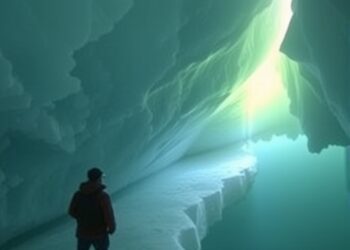In recent years, the engineering community has increasingly focused on the challenges posed by weak rock masses in foundational design. The stability and longevity of structures depend heavily on understanding the bearing capacity of foundations, particularly those resting on geological formations that show significant time-dependent behavior. A groundbreaking study by Motamedi Mamaghani, Zaheri, and Ranjbarnia, published in Environmental Earth Sciences, Caters to this precise need with a comprehensive numerical investigation into how temporal factors influence the bearing capacity of foundations on weak rock masses.
The bearing capacity of a foundation determines its ability to support loads without experiencing shear failure or excessive settlement. Traditionally, geotechnical analysis has treated this capacity as a relatively constant parameter, influenced primarily by instantaneous material properties and load conditions. However, the reality beneath our feet is far less static. Time-dependent degradation, creep, weathering, and stress redistribution can all significantly alter the mechanical properties of weak rock masses over time, thus compromising foundational stability.
This latest research utilizes advanced numerical modeling techniques to simulate the behavior of weak rock masses under varying load and environmental conditions. The study’s simulations incorporate parameters such as creep deformation, progressive failure mechanisms, and time-dependent reductions in shear strength. By integrating these complex processes into a cohesive numerical framework, the authors have achieved a more precise and predictive model of foundation bearing capacity that evolves over the lifespan of a structure.
One of the standout features of this investigation is its focus on weak rock masses — geological formations characterized by reduced intact strength, pervasive fracturing, and an innate susceptibility to environmental influences. Despite their prevalence, these materials have often been sidelined in engineering analyses due to the challenges in characterizing their behavior accurately. The insights provided by this study, therefore, mark a significant advancement in geotechnical engineering.
At the heart of the research is a sophisticated finite element model that realistically captures the mechanical responses of weak rock under sustained loading. The model’s architecture considers time-dependent phenomena such as creep, wherein rock masses under stress gradually deform, and subcritical crack growth, a process by which microfractures propagate slowly, reducing structural integrity over extended periods. These processes, often overlooked in traditional design standards, are crucial for anticipating long-term risks.
Moreover, the authors highlight how environmental factors, including moisture fluctuations and temperature variations, modulate the time-dependent behavior. Water infiltration can accelerate weathering and chemical alteration, softening rock interfaces and encouraging delayed failure. This environmental coupling necessitates integrating hydromechanical factors alongside the purely mechanical ones in any limit-state analysis.
Quantitatively, the simulations suggest that the effective bearing capacity of foundations on weak rock may degrade by significant margins—sometimes up to 30%—within decades post-construction under moderate loading conditions. Such reductions underscore the potential for catastrophic failures if temporal effects are not rigorously accounted for during the design phase. The researchers advocate for a recalibration of safety factors to incorporate these delayed strength losses explicitly.
The study’s implications extend beyond academic curiosity into real-world applications, as infrastructure increasingly encroaches on geologies riddled with weak rock masses. Urban development in mountainous or sedimentary basin regions, mining operations, and even renewable energy installations such as wind turbines all demand a granular understanding of foundation performance over time. Misestimating bearing capacity could lead to costly repairs, structural collapses, or even loss of life.
Crucially, the numerical approach presented proposes a pathway toward more resilient design codes. By parametrizing time-dependent effects, engineers and decision-makers can generate predictive maintenance schedules, implement real-time monitoring systems, and improve early warning mechanisms. This digital foresight tool allows better resource allocation and proactive mitigation strategies, ultimately enhancing societal safety margins.
The multidisciplinary nature of this work also signals a shift in how geotechnical engineering integrates with environmental sciences. The coupling of mechanical modeling with hydrogeological and chemical processes represents a new frontier in foundation research, reflective of the complex reality governing subsurface conditions. Such integrative frameworks pave the way for holistic infrastructure risk assessments.
While the study is numerical in essence, its authors emphasize the necessity of experimental validation. Field studies, in situ testing, and long-term monitoring campaigns are vital to calibrate and verify the modeled parameters accurately. Future research is likely to focus on refining these models with empirical datasets sourced from diverse weak rock environments worldwide.
In conclusion, the findings by Mamaghani, Zaheri, and Ranjbarnia substantially enrich our comprehension of time-dependent effects on foundation bearing capacity within weak rock masses. Their work offers a vital cautionary tale against static design assumptions while providing engineers with the tools to anticipate and counteract time-induced degradation effectively. The influence of their approach on both academic research and practical engineering practices is poised to be profound and enduring.
As infrastructure resilience takes center stage globally, harnessing these predictive insights becomes a linchpin for sustainable construction in geologically challenging contexts. This study not only bridges a critical knowledge gap but also empowers engineers with an enhanced predictive shield against the hidden risks lurking beneath our built environment, encouraging a smarter, safer future.
Subject of Research: Numerical investigation of time-dependent effects on foundation bearing capacity on weak rock masses.
Article Title: Numerical investigation of time-dependent effects on the bearing capacity of foundations on weak rock masses.
Article References:
Motamedi Mamaghani, F., Zaheri, M. & Ranjbarnia, M. Numerical investigation of time-dependent effects on the bearing capacity of foundations on weak rock masses. Environ Earth Sci 84, 610 (2025). https://doi.org/10.1007/s12665-025-12625-2
Image Credits: AI Generated




